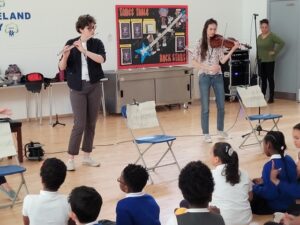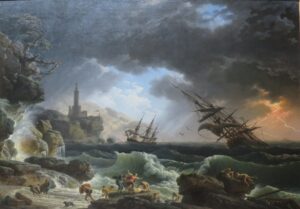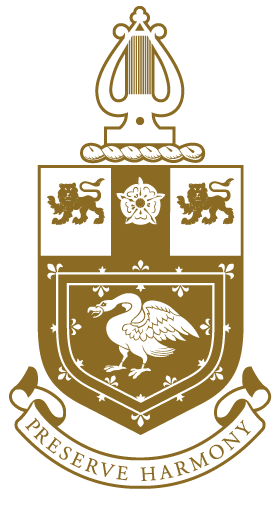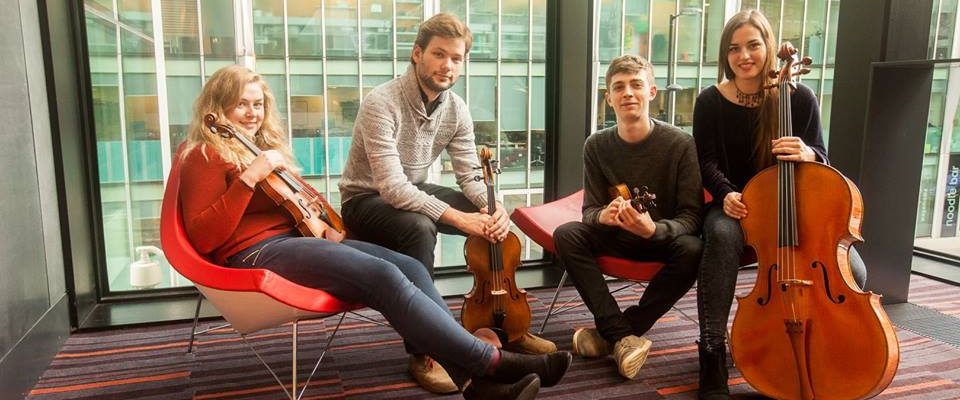Music in Schools: Moreland School’s Nautical Composition Project (Islington 2022)
Listen to the full school composition here:
 The National Gallery Take One Picture progamme was the inspiration for the Company’s Moreland Primary School project held in Summer 2022. Delivered by Company Young Artists Emma Arizza, Anna Kondrashina, Helena Svigelj and volunteer and Company Liveryman David Butcher, the project explored the deep connection between music and the visual arts. Violinist Emma Arizza, winner of the Musicians’ Company Award 2019, shares her experiences of this unique seven-week workshop.
The National Gallery Take One Picture progamme was the inspiration for the Company’s Moreland Primary School project held in Summer 2022. Delivered by Company Young Artists Emma Arizza, Anna Kondrashina, Helena Svigelj and volunteer and Company Liveryman David Butcher, the project explored the deep connection between music and the visual arts. Violinist Emma Arizza, winner of the Musicians’ Company Award 2019, shares her experiences of this unique seven-week workshop.
“I love finding new and creative ways to help different audiences discover the world of classical music so I was thrilled to get involved. While I’ve assisted and led on warm up routines for quite a few school participation projects both through the Company and as a Benedetti Foundation Ambassador, this was my first chance to unofficially take the lead.
This National Gallery Take One Picture programme is an annual initiative that invites primary schools to take one picture from the collection to inspire cross-curricular work in classrooms. Assigned ‘A Shipwreck in Stormy Seas’, a stormy seascape painted by Claude-Joseph Vernet in 1773, our overall aim was to help the children explore how images can work as an inspiration for sounds and to help them compose a piece of music in response to the painting. Selected works are showcased as part of a National Gallery Take One Picture exhibition.

One thing I’ve learnt in my work with schools is the need for a solid plan, which is invariably harder than it sounds. Often you have little understanding of the class or the children within it until you step foot in the room, so you have to anticipate a range of scenarios. You also need to be able to think on your feet, and be ready to adapt and modify your plan as you go along.
Invited by the school to deliver seven sessions to two classes of 25 pupils age 8-9 from diverse backgrounds, we began each workshop with a rhythmic clapping warm up using body percussion to get the children in the mood. This would usually lead to soundscape activities, in which the children would form small groups to find the instruments that best represent sounds such as birds, rain drops and thunder. In doing so, the children would learn about rhythm, melody and harmony – the key elements needed to compose their National Gallery response.
Using videos of concertos, such as Vivaldi’s Four Seasons, and our painting by Claude-Joseph Vernet as a source for discussion, we also explored how colours influence our music choice. The children discovered how the dark colours in the painting’s depiction of the storm’s aftermath linked more closely to minor scales and chords that have a dark, sadder sound. The children also explored ‘happier’ major scales.
For me, music is nothing but a form of entertainment and working with such a diverse group of children, some with very challenging life experiences, led to a wide range of views. Some of the children could only see the dark in the painting whereas I, and some of the other children, could see elements of light, demonstrating how experiences can shape our view of the world.
Classical music can be a hard thing for people to relate to but by linking pictures and videos to sound the children were able to see the role music plays in evoking feelings and mood. This helped them compose their Take One Picture response. With each class split into three groups, the children worked to find the words and melody for either the composition’s beginning, middle and end that best reflected the painting using the techniques they’d learnt in class. This recording was supported with improvisation from myself and Emma on flute, and later edited in Logic by Mercedes, the music teacher, who was hugely supportive.”
Later in the year the school created a sensory exhibition including the compostion and art work that the pupils had created as part of the project, a small glimpse of which can be seen here:
Interview by Suzy Willmott
Suzy is freelance copywriter who works with the Musicians’ Company





